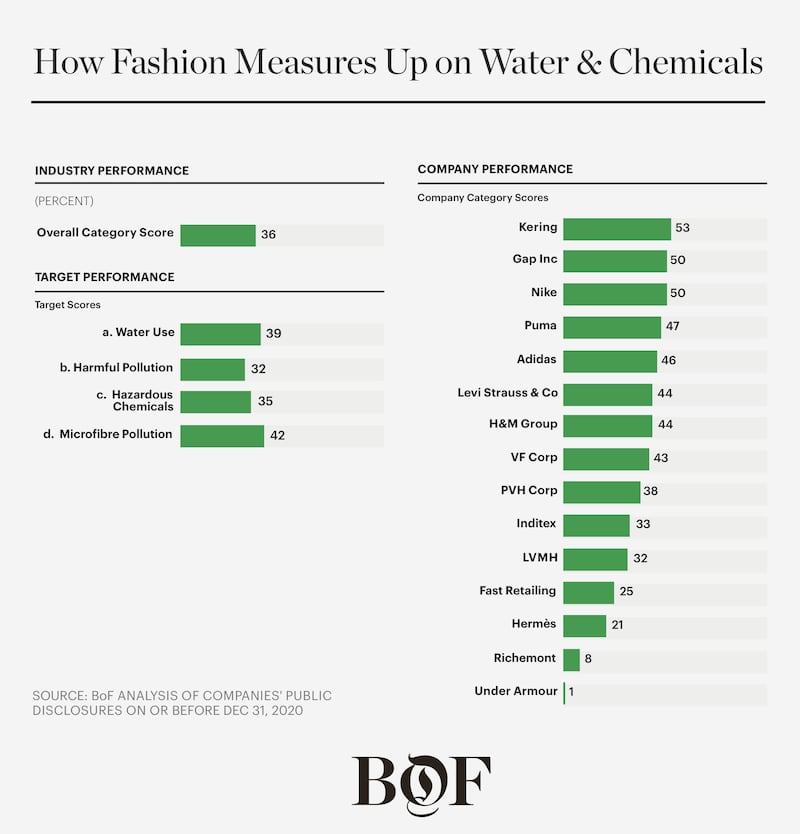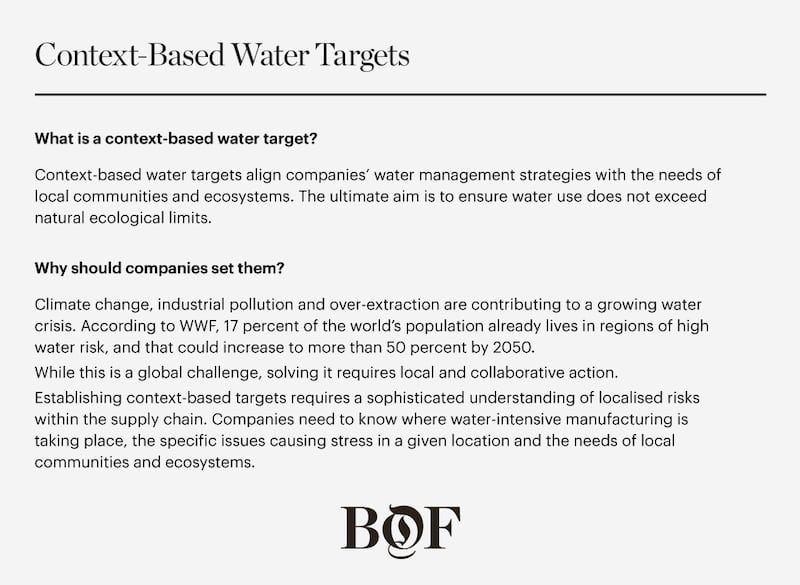
The Business of Fashion
Agenda-setting intelligence, analysis and advice for the global fashion community.

Agenda-setting intelligence, analysis and advice for the global fashion community.

This article appeared first in The Sustainability Gap, an in-depth analysis of BoF’s new report, The BoF Sustainability Index, which tracks fashion’s progress towards urgent environmental and social transformation. To learn more and download a copy of the report, click here.
The BoF Sustainability Index Water & Chemicals Targets:
a. Water Use — By 2030: Reduce water use to naturally replenishable levels.
b. Harmful Pollution — By 2030: Eliminate harmful pollution.
ADVERTISEMENT
c. Hazardous Chemicals — By 2030: Eliminate hazardous usage of chemicals.
d. Microfibre Pollution — The Baseline: Actively engage in industry efforts to minimise microfibre pollution.

The fashion industry’s impact on global water supply stretches from notoriously water- and pesticide-intensive cotton farms to the chemicals required to process materials and dye fabrics, and the microfibres that escape in the wash and reappear in the oceans.
Despite this, fashion is a laggard in disclosing its water risks and how companies are addressing them, according to a report published last year by environmental disclosure system, CDP. This lack of awareness suggests many companies may be underreporting or underestimating their risk exposure, the report found.
Companies’ approach to water management is becoming more sophisticated.
More momentum is needed to eliminate hazardous chemicals.
Microfibre pollution is an emerging area of focus.

The Sustainability Council’s Take
ADVERTISEMENT
“The UN Environment Programme’s latest global chemicals outlook reports that millions of tonnes of synthetic chemicals enter the global environment annually — many of which are hazardous to humans and the environment. Companies in the global fashion industry have worked for many years, collaboratively and individually, to address fashion’s portion of this problem. The reduction commitments and the infrastructure for more effective supply chain oversight mostly exist. But as this report shows, significant reductions in the industry’s chemical pollution are not evident. The industry would benefit from holding itself publicly accountable to reducing its chemical pollution by requiring companies to annually publish their chemical footprints, i.e. the quantitative measurement of the chemicals of high concern in products, manufacturing processes, facilities, supply chains and/or packaging. One structured mechanism for doing so is the Chemical Footprint Project, which allows companies to demonstrate to investors and the public the tangible outcomes of their chemicals management programmes.” — Boma Brown-West, Director, Safe and Healthy Products, Environmental Defense Fund
The BoF Sustainability Index is built on over 5,000 data points gathered across the 15 companies included in this year’s edition. To request access to the full underlying data, click here.
The BoF Professional Summit: Closing Fashion's Sustainability Gap
On April 14 2021, BoF will convene leading sustainability experts and global thought leaders for a 3-hour live broadcast of interactive conversations and panel discussions, in which we'll unpack findings from The BoF Sustainability Index and outline the steps that need to be taken over the coming decade to align the industry with global climate goals and social imperatives. Space is limited.
As a BoF Professional member, register now to reserve your spot. If you are not a member, you can take advantage of our 30-day trial to experience all of the benefits of a BoF Professional membership, including the Summit.
Explore all categories from this year's report:
The BoF Sustainability Index is based on a binary assessment that examines companies’ public disclosures up until December 31, 2020. There are limitations to this approach and while the assessment was conducted in good faith, the results should be viewed as a proxy for sustainability performance and not an absolute measure. Where BoF was unable to identify public evidence to support a company’s performance relating to the assessment criteria, it does not necessarily mean the company is taking no action at all or that bad practices are present. Read the full methodology on pages 38-41 in the report here or see the FAQs.
Disclaimer: LVMH is part of a group of investors who, together, hold a minority interest in The Business of Fashion. All investors have signed shareholders’ documentation guaranteeing BoF’s complete editorial independence.
The fashion industry continues to advance voluntary and unlikely solutions to its plastic problem. Only higher prices will flip the script, writes Kenneth P. Pucker.
The outerwear company is set to start selling wetsuits made in part by harvesting materials from old ones.
Companies like Hermès, Kering and LVMH say they have spent millions to ensure they are sourcing crocodile and snakeskin leathers responsibly. But critics say incidents like the recent smuggling conviction of designer Nancy Gonzalez show loopholes persist despite tightening controls.
Europe’s Parliament has signed off rules that will make brands more accountable for what happens in their supply chains, ban products made with forced labour and set new environmental standards for the design and disposal of products.